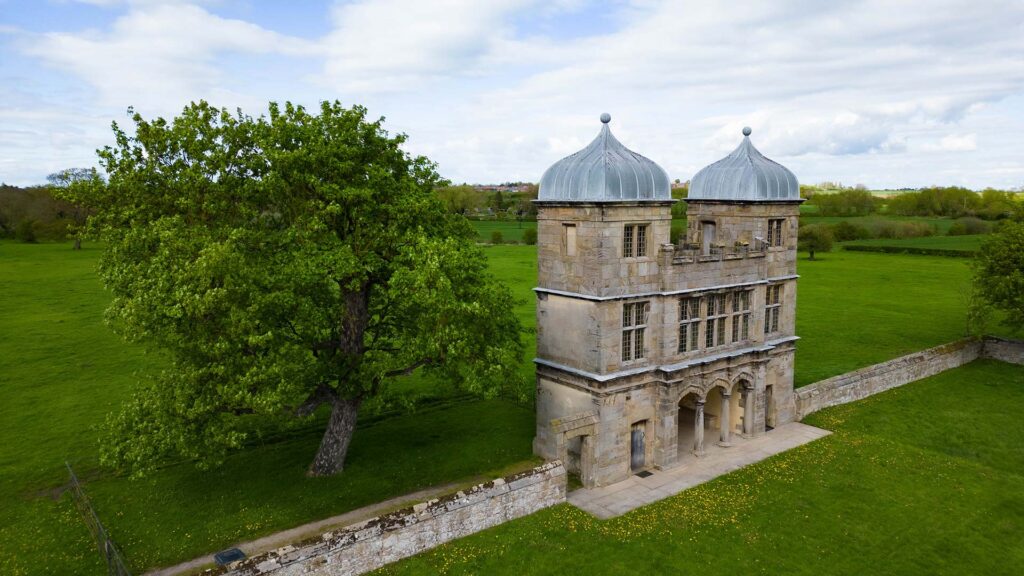Swarkestone Hall Pavilion
The Swarkestone Pavilion was a mystery for a long time, as no one knew exactly when it was built, who designed it, or how it related to the rest of the property. Even its name was uncertain and had been called the Stand, Grandstand, Bullring, or Summerhouse. Despite the uncertainties, everyone acknowledged that it was an impressive architectural structure.
This type of building is similar to the Elizabethan and Jacobean prodigy houses, but in a smaller size.
In 1560s, Sir Richard Harpur, a lawyer who gained eminence under the patronage of the Earl of Shrewsbury and married Jane Findern, an heiress, built a new house with 28 hearths at Swarkestone. In 1622, John Harpur, his grandson, who was ten years old at that time, inherited the estate. In 1630, John took possession of his inheritance and was knighted in the same year. He was also set to marry Catherine Howard, who was the granddaughter of the Earl of Suffolk and the stepdaughter of William Cavendish. Records from 1631-2 show expenses for their wedding, including gloves, gauntlets, and liveries, as well as preparations made to Swarkestone Hall, where they planned to live.
It is possible that the Pavilion was constructed to commemorate the marriage of a young couple, as their coat of arms can be seen on the shields at the front. In the accounts for 1631-2, there was a payment of £111 12s 4d made to Richard Shepperd the mason for “New Buildynge,” along with a payment for “Boardes” for the “Bowle Alley house.”It appears likely that the Pavilion can be dated back to 1631-2, and there are strong links to the Shepperd family, who were prominent masons in the area at the time. It is unclear whether Richard Shepperd was the designer, although he is known to have built the ‘Gothic Survival’ church at Staunton Harald and referred to himself as an “Architecter” in his will. According to the Harpur accounts, Mr. Woolridge was the Bowl Alley Surveyor. Mark Girouard has proposed that John Smythson may be the architect of the Pavilion based on its style. This suggestion seems plausible because Smythson had worked with William Cavendish, and Cavendish’s step-daughter was married to Sir John Harpur, creating multiple connections between the two families.
Aerial Footage of Swarkestone Hall Pavilion
The accounts reveal that the Pavilion should be associated with the garden rather than the park’s violent folklore. It was actually a banqueting house overlooking a bowling green, likely a component of a formal garden design. It’s important to mention that in the estate documents from the previous century, it was referred to as the Bowling Green Pavilion on occasion. It’s possible that it also functioned as a banquet house where guests could retreat to enjoy fine wines and sweet treats, play card games, or simply appreciate the view of the host’s estate.
The confusion surrounding the Pavilion’s surroundings is due to the site’s later history. When Sir John, the last member of his branch of the family, passed away in 1679, the estate was inherited by the Harpurs of Calke. The house was then taken apart between 1746 and 1748. The structure has high walls with windows, doors, and a fireplace that may help to visualize its shape. The building has been preserved for its aesthetic appeal, similar to the Pavilion, and they both appear to have symmetry with an old door in the opposite wall. The formal layout of gravel paths that was recorded in a paddock west of the walls in 1988 and the rectangular pond that used to be situated to the east of the walls support this theory. It is worth noting that in the early 19th century, Swarkestone was a hub for breeding and selling livestock. As a result, it is possible that some of the walled enclosures, including the one in front of the Pavilion, might have been used for this purpose as well.
In 1844, the cupola roofs were repaired after one was hit by lightning, but despite the repair, the Pavilion fell into disrepair. The Pavilion gained attention in 1968 when the Rolling Stones used it to promote their album Beggar’s Banquet. Another picture from the same photoshoot was later used on the back of a compilation album called Hot Rocks 1964-1971.

